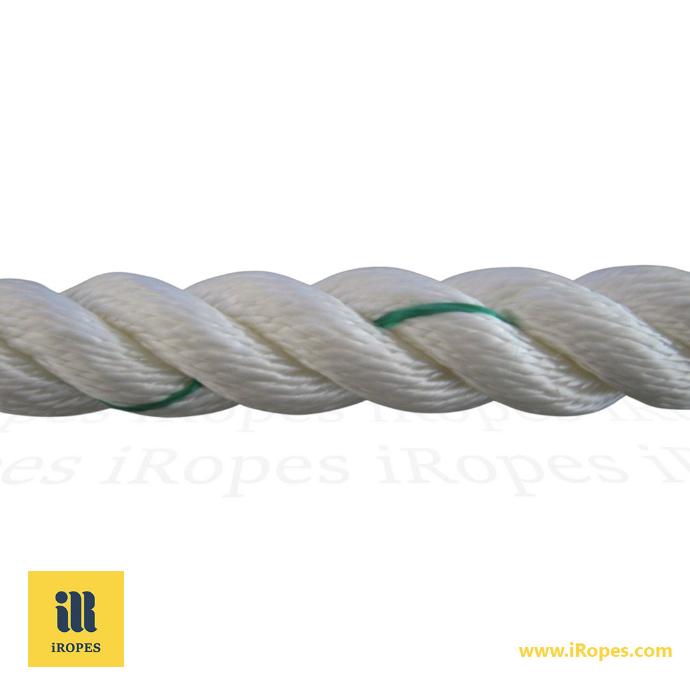In the world of ropes, few designs have proven as versatile and dependable as the twisted rope. With its unique construction and inherent advantages, this unassuming yet essential tool has become a staple across a wide range of industries and applications, from the rugged outdoors to the precision-driven world of construction.
Whether you're an avid adventurer, a professional rigger, or simply someone who appreciates the value of a well-crafted tool, understanding the benefits of twisted rope can help you make informed decisions and optimize your performance, safety, and efficiency.
In this blog post, we'll delve into the remarkable advantages of twisted rope that you simply can't afford to miss. From its unparalleled versatility and strength to its enhanced flexibility and ease of handling, we'll uncover why twisted rope has become the go-to choice for countless professionals and enthusiasts worldwide.
So, get ready to discover the twisted secrets that make twisted rope a cut above the rest, and learn how 1 twisted rope can take your performance to new heights, no matter your passion or profession.
The Versatility of Twisted Rope
Have you ever stopped to appreciate the incredible versatility of twisted rope? This unassuming yet essential tool has been a staple in human society for centuries, serving a multitude of purposes across various industries and applications. From ancient times to the modern day, twisted rope has proven its worth time and time again, thanks to its unique construction and inherent properties.

Types and Construction of Twisted Ropes
The secret to twisted rope's versatility lies in its construction. By tightly twisting individual strands together, manufacturers create a strong, durable, and flexible rope that can withstand a variety of conditions. The type of material used can further enhance these properties, with common options including:
- Nylon twisted ropes: Known for their strength, moisture resistance, and suitability for marine applications.
- Polyester twisted ropes: Offering low stretch and excellent abrasion resistance, making them ideal for heavy-duty tasks.
- Cotton twisted ropes: Eco-friendly and perfect for crafting, decorative purposes, and light-duty applications.

3-strand polyester line developed specifically for use as a luff line and
featuring high elasticity.
MATERIAL: polyester
CONSTRUCT: 3-strands
ELONGATION: 26%
Each material brings its own unique characteristics to the table, allowing users to select the perfect twisted rope for their specific needs. Whether you require a rope that can withstand harsh outdoor conditions or one that is soft and pliable for indoor use, there's a twisted rope out there for you.
Applications and Uses of Twisted Ropes
Now, let's dive into the myriad applications and uses of twisted ropes. From the great outdoors to the comfort of your home, these versatile tools prove their worth in countless scenarios:
- Marine activities, such as boating, sailing, and fishing
- Outdoor pursuits, including camping, hiking, and climbing
- Agriculture and farming, for tasks like animal handling and fence-making
- Construction and industrial applications, such as lifting and securing loads
- Crafting and decorative purposes, from macrame to home decor
The list goes on and on. No matter your passion or profession, there's a good chance that twisted rope plays a role in making your life easier, safer, and more efficient. So the next time you reach for a piece of twisted rope, take a moment to appreciate its incredible versatility and the countless ways it enhances our world.
When selecting a twisted rope for your specific application, consider factors such as the required strength, durability, flexibility, and resistance to the elements. By choosing the right type of twisted rope, you can ensure optimal performance and longevity, making your tasks and projects a resounding success.
The Impact of Twisting on Rope Strength and Durability
When it comes to choosing the right rope for your needs, understanding how twisting affects strength and durability is crucial. Let's take a closer look at the science behind twisted rope construction and explore the factors that influence its performance.
How Twisting Affects Rope Performance
Have you ever wondered why some ropes seem to handle heavy loads with ease while others quickly fray and break? The answer lies in the way the strands are twisted together. In a twisted rope, the individual fibers are wound tightly around each other, creating a compact structure that allows for efficient load sharing.
This load sharing ability is one of the key advantages of twisted rope construction. When tension is applied, the force is distributed evenly across the strands, reducing stress on any single fiber. This results in enhanced overall strength and the ability to withstand higher loads without failure.
However, it's important to note that the degree of twisting can significantly impact a rope's performance. Over-twisting can lead to reduced flexibility and an increased risk of kinking, while under-twisting may compromise the rope's structural integrity. Finding the perfect balance is essential for optimal strength and durability.
Factors Influencing Twisted Rope Strength
In addition to the twisting process itself, several other factors play a role in determining the strength and longevity of twisted ropes:
- Fiber material: Synthetic fibers like nylon, polyester, and HMPE (high-modulus polyethylene) generally offer superior strength and durability compared to natural fibers like cotton or manila.
- Fiber density: Higher fiber density results in a stronger, more compact rope that can withstand greater loads and resist abrasion.
- Coatings and treatments: Applying protective coatings or treatments to the fibers can enhance resistance to UV radiation, chemicals, and moisture, extending the rope's lifespan.
- Construction method: The specific way in which the strands are twisted together (e.g., single twist, double twist, or triple twist) can influence the rope's overall strength and performance characteristics.
By considering these factors and selecting high-quality materials, manufacturers can produce twisted ropes that excel in strength and durability, making them suitable for a wide range of demanding applications.
So, whether you're a professional rigger securing heavy loads on a construction site or an outdoor enthusiast relying on your rope for safety during a climbing expedition, you can trust in the strength and resilience of a well-constructed twisted rope.
In the next section, we'll explore how the twisted design enhances flexibility and handling, making twisted ropes a top choice for users who require a versatile and easy-to-use solution for their rope needs.
Exploring the Improved Flexibility and Handling of Twisted Ropes
Picture this: you're out on a sailing adventure, navigating through choppy waters and relying on your trusty ropes to keep everything secure. As you adjust the rigging, you can't help but appreciate the way your twisted ropes bend and conform to the shapes you need, making your job a whole lot easier. But have you ever stopped to wonder what makes twisted ropes so flexible and easy to handle compared to their single-strand counterparts?
As it turns out, the secret lies in the construction of twisted ropes. By intertwining multiple strands together, manufacturers create a rope that is not only stronger but also more flexible and adaptable to various situations. This improved flexibility and handling is what makes twisted ropes a top choice for a wide range of applications, from marine activities to construction and beyond.
What Makes Twisted Ropes Flexible?
So, what exactly contributes to the impressive flexibility of twisted ropes? Let's dive into the factors that make these ropes so easy to work with:
- Multi-strand construction: Unlike single-strand ropes, twisted ropes consist of multiple strands twisted together, allowing for greater flexibility and movement between the strands.
- Lay lengths: The length of each strand's twist, known as the lay length, plays a crucial role in determining the rope's flexibility. Longer lay lengths result in a more flexible rope, while shorter lay lengths create a stiffer rope.
- Gaps between strands: The small spaces between the twisted strands allow the rope to bend and conform to shapes more easily, enhancing its overall flexibility.

By adjusting factors like the number of strands, lay lengths, and the gaps between them, rope manufacturers can fine-tune the flexibility of their twisted ropes to suit specific applications. For example, a rope designed for rock climbing may have a tighter twist and shorter lay lengths for reduced stretch and greater safety, while a rope meant for decorative purposes may have longer lay lengths and larger gaps for increased flexibility and ease of tying knots.
The Benefits of Improved Flexibility in Twisted Ropes
Now that we understand what makes twisted ropes so flexible, let's explore the real-world benefits of this increased flexibility:
- Easier handling and maneuverability: Flexible twisted ropes are much easier to handle and manipulate, making them ideal for applications where quick adjustments and precise control are essential.
- Adaptability to different shapes and structures: The improved flexibility of twisted ropes allows them to conform to various shapes and structures, making them suitable for use in a wide range of environments and situations.
- Enhanced safety and efficiency: In applications like rigging, climbing, and marine activities, the flexibility of twisted ropes can lead to safer and more efficient operations, as the ropes can bend and adapt to the required shapes without compromising strength or stability.
From tying secure knots to threading through tight spaces, the improved flexibility of twisted ropes makes them a versatile and reliable choice for professionals and enthusiasts alike. So the next time you reach for a twisted rope, take a moment to appreciate the ingenious design that makes your life a little bit easier and a whole lot safer.
In conclusion, the improved flexibility and handling of twisted ropes are a testament to the power of innovative design and engineering. By understanding the factors that contribute to these properties, we can better appreciate the incredible versatility and adaptability of twisted ropes in a wide range of applications. Whether you're a sailor, a climber, or simply someone who appreciates a well-crafted tool, twisted ropes are sure to impress with their unparalleled flexibility and ease of use.
For those with unique rope needs, iRopes offers extensive customization services to ensure you get the ideal rope tailored to your specific requirements.
Twisted rope stands out for its unmatched versatility, finding applications in diverse industries such as marine, agriculture, and construction. Its twisted construction enhances strength and durability, capable of withstanding heavy loads without losing integrity. Users benefit from the improved flexibility and easier handling of 1 twisted rope, making it a preferred choice for various tasks including knotting, splicing, and thread manipulation. For anyone seeking a reliable and adaptable solution, twisted rope offers significant advantages in performance and safety across multiple applications.
Contact Us for Custom Rope Solutions
If you’re looking to harness the unique benefits of rope twisted for your specific needs, fill in the form above, and our iRopes specialists will assist you in finding the perfect solution.